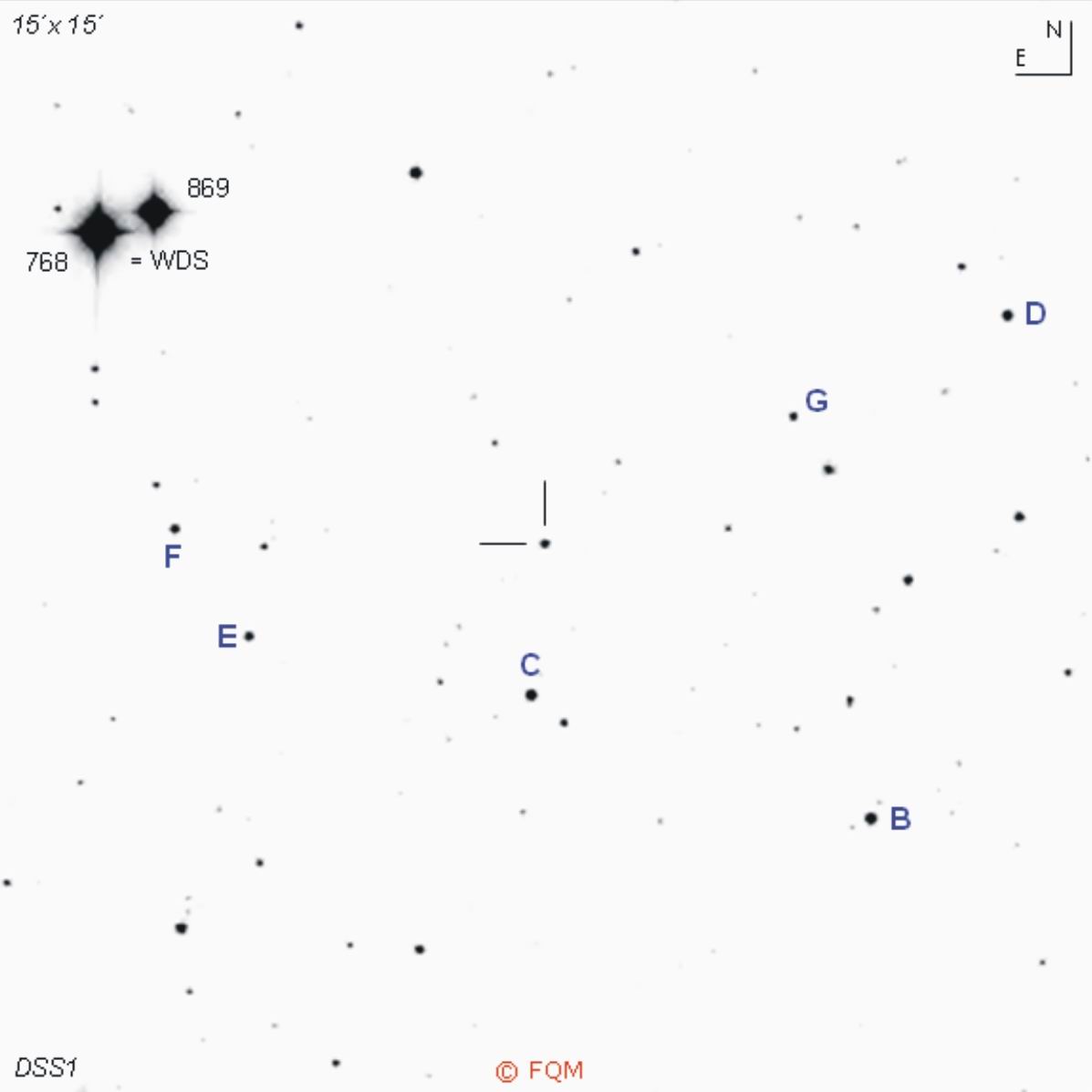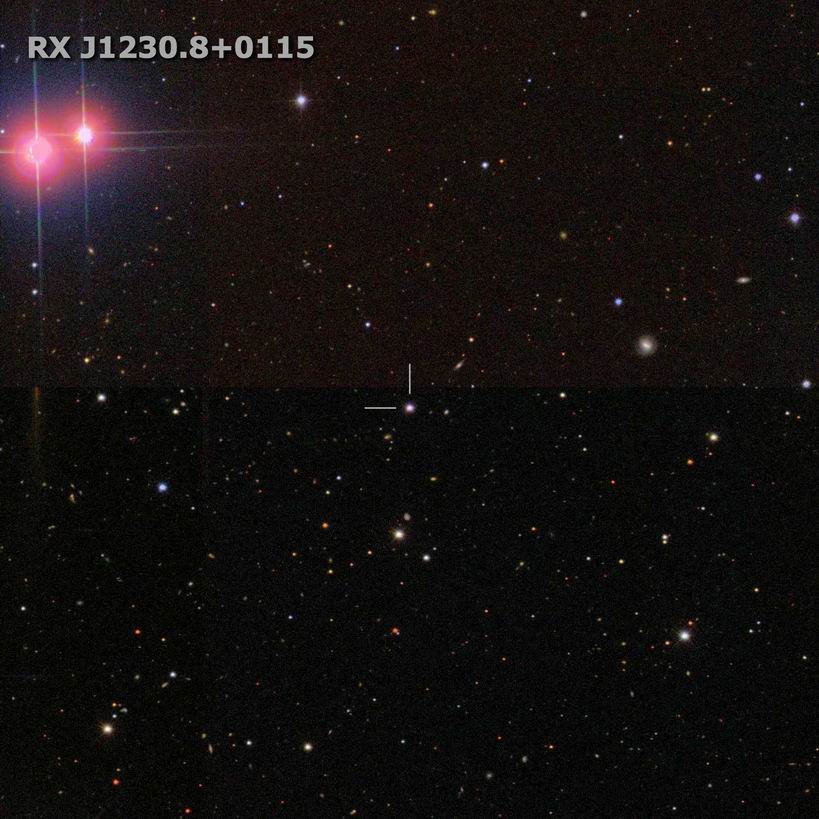
| Frankfurt Quasar Monitoring |
| RX J1230.8+0115 |
| Cross-Identifications | QSO B1228+0131, SDSS J123050.03+011522.6 QSO J1230+0115, 2MASS J12305003+0115226 HE 1228+0131, 1RXS J123050.4+011526 GALEXASC J123050.07+011522.5 |
| Equat. coordinates | RA 12 30 50.0 DE +01 15 21 (J2000) |
| Constellation | Virgo |
| Type | QSO |
| Redshift | z=0.117 |
| Distance (2) (3) | 473 Mpc |
| Total mag range (mv) (4) (5) | 14.4 - 14.8 |
| Catalog Magnitude (1) | 14.42 |
| Absolute Magnitude (1) | -24.8 MB |
| Light Travel-Time (2) | 1.460 × 109 yrs |

Comparison stars
| star | B | V |
| B | 14.411 (0.055) |
13.803 (0.038) |
| C | 14.803 (0.052) |
14.066 (0.059) |
| D | 14.756 (0.046) | 14.266 (0.033) |
| E | 14.928 (0.075) | 14.751 (0.020) |
| F | 15.661 (0.051) | 15.069 (0.016) |
| G |
16.124 (0.082) | 15.754 (0.144) |


| RX
J1230.8+0115
is a bright radio-quiet quasar in Virgo,
3.3° NE of Eta Vir, and only about 1° SE of famous quasar 3C 273. At
a distance of about 1.4×109
light-years, RX
J1230.8+0115 is
located in the far cosmological background of the southern
extension of the Virgo galaxy cluster. In
the early 1990s, quasar RX J1230.8+0115
was discovered as an X-ray source by ROSAT. During follow-up
observations,
carried out by the Edinburgh UVX Quasar Survey, the new source was
identified with a stellar
object that showed a Seyfert
1-spectrum.
At the time of discovery, this newly found
quasar was # 9
among the brightest quasars in the sky. It remains unclear why this
bright quasar was not detected by the
Palomar-Green Survey (1976-1992). The PG-Survey was the only survey
that
previously scanned this area of the sky searching for blue stellar objects as
potential quasar candidates. Probably,
quasar RX J1230.8+0115
underwent larger flux changes in the past. RX J1230.8+0115 is a low amplitude variable object. According to the Frankfurt Quasar Monitoring programme, the total optical variability ranges only within a few tenth of a magnitude. CCD observers, as well as visual observers, shall use the comparison stars given above. For visual observers with apertures of 10- to 12-inch and larger, this quasar appears as a stellar object - even with large aperture telescopes. ____________
Right next to the quasar there is a nice triple star, WDS 12312+0120, only 7´NE (see finding chart above, labelled as WDS). The 7.7-mag primary and the 8.7-mag secondary are separated by 49". The third component is a 10.5-mag star, only 5" N of the secondary. The star field NE of quasar RX J1230.8+0115 shows two bright 11-mag spirals, about 1.4° to the NE: NGC 4536 and NGC 4527. Both galaxies are type SBbc-spirals and members of the Virgo galaxy cluster. As mentioned above, another quasi-stellar object, famous quasar "superstar" 3C 273 can be found only 1° NW and is a must for all observers. Due to the proximity to 3C 273, the author calls QSO RX J1230.8+0115 "the fainter little brother of 3C 273". So when you are around for quasar RX J1230.8+0115, why not taking a look at 3C 273 as well ? Another violently variable quasar, 3C 279, can be found by moving the scope some 9° to the SE. 3C 279 is located at a whopping distance of some 5×109 light-years. |
| Goldschmidt, P., Miller, L. 1998, MNRAS, 293, 107; The UVX quasar optical luminosity function and its evolution. Karge, S.; Helle Quasare für 8- bis 10-Zoll Teleskope. Ein Beobachtungsführer zur visuellen Beobachtung von Quasaren und BL Lacertae Objekten; Frankfurt 2005. Read, M.A., Miller, L., Hasinger, G. 1998, A&A, 335, 121; A bright QSO near 3C273. Véron-Cetty, M.-P., Véron, P. 2001, A&A 374, 92; A Catalogue of Quasars and Active Nuclei: 10th edition. Véron-Cetty, M.-P., Véron, P. 2003, A&A 412, 399; A Catalogue of Quasars and Active Nuclei: 11th edition. Véron-Cetty, M.-P., Véron, P. 2006, A&A 455, 776; A Catalogue of Quasars and Active Nuclei: 12th edition. Véron-Cetty, M.-P., Véron, P. 2010, A&A 518, 10; A Catalogue of Quasars and Active Nuclei: 13th edition. |
| Links: Sloan Digital Sky Survey APASS |
| home |